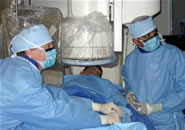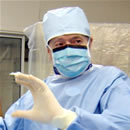
|
July 20, 2008 -- New York -- The recently published M.O.R.T.A.L. study showed that catheterization, angioplasty and stenting utilizing the wrist artery for access halve the complication rates seen in the femoral (groin/leg) approach and are associated with a significant reduction in mortality. Even so, the wrist approach, called transradial access, has not been practiced much in the United States. According to Dr. Kirk Garratt of the Lenox Hill Heart and Vascular Institute of New York, one reason the radial procedure is less used in the U.S. has to do with the training process for cardiologists:
However, training opportunities for cardiologists to learn the wrist technique are becoming more popular. St. Vincent's Hospital in New York has announced it's third course this year, noting that its June course was fully enrolled weeks in advance. Dr. John T. Coppola, Chairman of Cardiology at St. Vincent's Hospital in Manhattan and Dr. Tak Kwan, Director of the Cardiac Catheterization Laboratory and Interventional Cardiology at The Brooklyn Hospital Center of New York, will be presenting a two-day hands-on training course for cardiologists on the clinical, didactic and practical aspects of Transradial Access, including tips and tricks, equipment usage, pharmacology, and patient, physician and hospital benefits. In addition, physicians will get to practice cases with transradial simulators and participate in live-case presentations as well. The course will be held on October 1-2, 2008 at St. Vincent's Hospital in Greenwich Village, New York. A brochure and registration information are available online.
To assist in educating the professional and patient population in the U.S. about the this technique, Angioplasty.Org has created the "Radial Access Center for Transradial Approach", a special section devoted to information and news about the transradial technique, for both patients and physicians. The Radial Center features interviews with leading practitioners of the radial technique, such as Drs. Mauricio Cohen, Jeffrey Popma, R. Lee Jobe, John Coppola, Kirk Garratt and Howard Cohen. For patients there is also a "Hospital Locator" that lists U.S. centers practicing radial angiography. As Dr. Howard Cohen, also of Lenox Hill Hospital, says of the wrist technique, "Patients really prefer it. 95% of people who've had it both ways would say 'I'm coming back to you, Dr. Cohen because I like this transradial a lot better than the other way!'" Details on registering for this course are available in this online brochure. The course is being held on Wednesday and Thursday, October 1-2, 2008, at:
The course receives support from Terumo Interventional Systems. |

